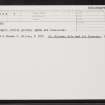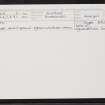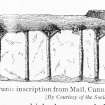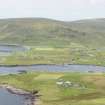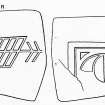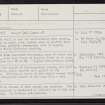Pricing Change
New pricing for orders of material from this site will come into place shortly. Charges for supply of digital images, digitisation on demand, prints and licensing will be altered.
Mail Cemetery
Burial Ground (Early Medieval), Chapel (Early Medieval), Gravestone (17th Century), Ogham Inscribed Stone(S) (Early Medieval), Rune Inscribed Stone(S) (Norse)
Site Name Mail Cemetery
Classification Burial Ground (Early Medieval), Chapel (Early Medieval), Gravestone (17th Century), Ogham Inscribed Stone(S) (Early Medieval), Rune Inscribed Stone(S) (Norse)
Alternative Name(s) Dunrossness, Cunningsburgh Church; Mail Graveyard
Canmore ID 938
Site Number HU42NW 5
NGR HU 43246 27926
Datum OSGB36 - NGR
Permalink http://canmore.org.uk/site/938
- Council Shetland Islands
- Parish Dunrossness
- Former Region Shetland Islands Area
- Former District Shetland
- Former County Shetland
Mail 2 (St Columba/St Paul), Cunningsburgh, Shetland, ogham-inscribed fragment
Measurements: 0.32m by 0.19m, D 0.07m
Stone type: sandstone
Place of discovery: HU 4330 2790
Present location: National Museums Scotland, Edinburgh (IB.115)
Evidence for discovery: found in 1874 or 1875 ‘close-by the burial-ground’ at Mail. It was presented to the museum in Edinburgh in 1883.
Present condition: one edge is broken but the ogham letters are clear.
Description
This triangular fragment is incised with ogham letters along one broad face continuing over to one narrow face, and a second partial inscription on another narrow face. Forsyth suggests that the letter forms may indicate an earlier date compared to the other two fragments of ogham inscriptions from the vicinity (Mail 3 and South Voxter).
Date: seventh or eighth century.
References: Forsyth 1996, (Cunningsburgh 2) 213-19, 225-6; Scott & Ritchie 2009, no 51.
Compiled by A Ritchie 2016
Mail 3 (St Columba/St Paul), Cunningsburgh, Shetland, ogham-inscribed fragment
Measurements: H 0.29m, W 0.45m, D 0.05m
Stone type: micaceous sandstone
Place of discovery: HU 4330 2790
Present location: National Museums Scotland, Edinburgh (IB.182)
Evidence for discovery: found during grave-digging in Mail churchyard in 1903.
Present condition: broken top and bottom, but parts of two vertical edges are intact as well as parts of the inscription.
Description
This fragment appears to have come from a larger and probably upright monument, incised on one broad face with parts of three vertical lines of short ogham letters on stems.
Date: possibly ninth century.
References: Forsyth 1996, (Cunningsburgh 3) 219-26; Scott & Ritchie 2009, no 53.
Compiled by A Ritchie 2016
Mail 5 (St Columba/St Paul), Cunningsburgh, Shetland, Pictish cross-slab fragment
Measurements: H 0.27m, W 0.45m, D 0.04m
Stone type: fine-grained red sandstone
Place of discovery: HU c 4323 2789
Present location: Shetland Museum, Lerwick (A42.2008)
Evidence for discovery: found in 2008 buried at a depth of some 2m amongst other stones west of the site of the medieval church in Mail cemetery. The addition of the date 1769 suggests that the stone was found and re-used as a memorial in the eighteenth century.
Present condition: the edges are all damaged or broken, apart from a short length of the left-hand edge. The lower part of the surface has flaked, losing part of the carved symbol. The stone appears to have been trimmed into a pedimental shape, perhaps for re-use as a later gravestone.
Description
This fragment is carved in relief and incision on one broad face, and the surviving portion of face D is plain. Face A has a plain flatband border, within which a narrow flatband moulding acts as a frame for the carved design. Spanning the width of the slab is a double disc and Z-rod, although the lower arm of the incised Z-rod is damaged by flaking of the surface. The double disc is outline by a narrow roll moulding, and within each of the two discs is an incised cross-of-arcs with a square centre and a central small pit or compass point. Separated from the symbol by a horizontal flatband moulding is the remains of an interlaced design. This appears to have been a cross-slab rather than a simple symbol stone.
Date: late eighth to late ninth century.
References: Ritchie 2008; Scott & Ritchie 2009, no 5.
Compiled by A Ritchie 2016
Mail 1 (St Columba/St Paul), Cunningsburgh, Shetland, rune-inscribed fragment
Measurements: H 1.03m, W 0.16m, D 0.19m
Stone type: sandstone
Place of discovery: HU 4330 2790
Present location: National Museums Scotland, Edinburgh (X.IB.103).
Evidence for discovery: found in 1877 re-used in the churchyard wall at Mail.
Present condition: worn.
Description
The narrow face of the slab bears clear runic letters, forming part of a memorial inscription: ‘in memory of his/her father, Thorbjorn’.
Date: early eleventh century.
References: Barnes & Page 2006, SH 3, 126-31; Scott & Ritchie 2009, no 76.
Compiled by A Ritchie 2017
HU42NW 5 4324 2791
(HU 4323 2792) Chapel (LB) (Site of)
OS 6" map, Shetland, 2nd ed., (1903).
HU42NW 5.01 HU 4330 2790 Pictish Symbol Stone
HU42NW 5.02 HU 4325 2790 Viking Antler Comb
HU42NW 5.03 HU 4325 2790 Whorl
HU42NW 5.04 HU 4325 2790 Stone; Cross (Possible)
HU42NW 5.05 HU 4325 2790 Viking Strap End
HU42NW 5.06 HU 4325 2790 Stone
HU42NW 5.07 HU 4325 2790 Stone
This was the church of Cunningsburgh parish, now part of Dunrossness, which existed as a parish at the Reformation. Nothing is known of the church except that it was the recognised church of the area from a very early date.
G Goudie 1879.
Ogham and Rune inscribed fragments, most of which are in the National Museum of Antiquities of Scotland (NMAS), have been found at various dates on or near this site (See also HU42NW 10).
RCAHMS 1946.
Graveyard still in use and well-covered with graves. Low platform on north side, better seen in profile than on ground plan, probably represents site of chapel. Nothing else Early Christian visible.
A MacDonald 1967 (Ms notes).
There are no traces of this chapel now visible. The platform mentioned by MacDonald is unlikely to be the site of the chapel. No further information.
Visited by OS (WDJ) 8 May 1968.
Class I symbol stone.
A Mack 1997.
Field Visit (14 July 1931)
Chapel, Mail, Cunningsburgh. Nothing remains of this chapel, but at the date of visit there stood, erected against the wall of the graveyard, a slab, which has since been removed to the modern church. Round its margin runs the following inscription: HERE LYES THE DUS/T OF ANE HOPFULL YOUNG GENTLEWOMAN I CALLED ANNA FOREST/ER LAWFULL DAUGHTER TO IOHN FORESTER CHAMBERLAYN OF ZETLA/ND WHO DIED NOVEMBER 11 16[?9]1 AND / OF HER AGE 1[?8] YEIR.* In the upper part of the field is a shield with helmet and mantling, charged: Three hunting horns, stringed, and a cross-patty in base. The device is flanked by the initials A F and below is the quatrain: THE PIOUS YOUNG PASSE HENCE TO GLORE WHILE IMPIOUS OLD HERE LAY UP STORE. Underneath is the upper part of a skeleton upholding a label inscribed MEMENTO MORI, and about it are arranged such symbols as hour-glass, spade and mattock, cherubs, etc. The resemblance between this stone and that found at Garth (No. 1281) suggests that both may have been carved by the same hand.
On or near this site have been found at various times the following fragments of stones inscribed with oghams or runes. All except No. 3 are in the National Museum.
(1) A fragment of greyish sandstone, 10 in. by 8 in. by 2 ¼ in, bearing ogham letters reading I R or R I, with a portion of an angulated group of scores (en.1). The scores making I R or R I are interesting as being specimens of bundle oghams.
(2) A fragment of grey sandstone, 13 in. by 7 ½ in. by 2 ½ in., bearing parts of two ogham inscriptions, one cut on a stem line and the other on the angle of the stone. Rhys read:
EHTECONMO RSA/FVI and D/QU [U/E] V [O/U] DDRS [see original], finding in the first group two proper names ‘Ehtecon’ and ‘Morv’ (regarded as part of ‘Morbet’), but not suggesting any translation of the second (en.2).
(3) A smaller fragment, found about the same time and at the same place as the last, which was retained by the finder, is now apparently lost (en.3).
(4) A small piece of a slab of micaceous sandstone, 20 in. by 10 in. by 2 ¼ in, bearing on one face parts of three lines of an ogham inscription of which no reading has yet been given (en.4).
(5) A rune-inscribed stone found at the depth of 3 ft. below the bed of a stream. Professor Stephens of Copenhagen read the inscription as KVIMIK, which he regarded as signifying [HA]KVI MIK, ‘[he] wed me’ or ‘[he] carved me’, i.e. the stone (en.5).
(6) A smaller fragment, found close to the last, showing two pairs of runes, read as KT and TK, forming parts of two separate words (en.6).
(7) A piece of hewn sandstone, 4 ft. 3 in. long, 6 in. broad, and 6 in. thick, inscribed with runes. A number of the characters at the beginning of the inscription are defaced, but Professor Stephens suggested the following reading:
[ .... RIS] THI STIN IFTIR FOTHUR SIN THURBAIR[N] ‘[ .... rais] ed this stone after his father Thurbair[n]’ (en.7)
RCAHMS 1946, visited 14 July 1931.
OS 6" map, Shetland, 2nd ed., (1903).
(1) P.S.A.S., xxxii (1897-8), p. 376.
(2) Ibid., pp. 374-6.
(3) Goudie, The Celtic and Scandinavian Antiquities of Shetland, p. 53.
(4) Ibid., p.54.
(5) PSAS, xiii (1878-9), p. 144.
(6) Ibid., p.145.
(7) Ibid., pp. 145-53.
* A tradition to the effect that Anna Forester died from being struck on the head with a bunch of keys.
Artefact Recovery (2008)
HU 432 279 A fragment of an Early Historic sculptured stone slab with relief carving on one face was found in grave-digging in Mail churchyard. The main feature is a double disc and Z-rod with the unusual addition of a cross of arcs decorating each of the circular fields of the discs. There is also a fragment of interlace above the Pictish symbol, although it is unclear whether the fragment is part of a cross-slab. This example complements the previous find of the ‘Mail stone’ from the same graveyard.
Claimed as Treasure Trove (TT20/08) and allocated to Shetland Museum
Martin Goldberg – National Museums Scotland
Field Visit (30 September 2015)
Slightly more erosion than recorded in 2014 but has not changed significantly.
Visited by Scotland's Coastal Heritage at Risk (SCHARP) 30 Sept 2015
Field Visit
Coastal exposure on the seaward side of current cemetery. Approx 11m long, 1m high. Deep rich soil containing moderate small frags of bone. Human and animal bone observed. Below the topsoil in an approx 3m length of the section a line of flat stones overlies peat ash.
Approx. 20m west a further 2m wide by 1m high coastal exposure contains thick cultivation soil with animal bone fragments.
Visited by Scotland's Coastal Heritage at Risk (SCHARP)













